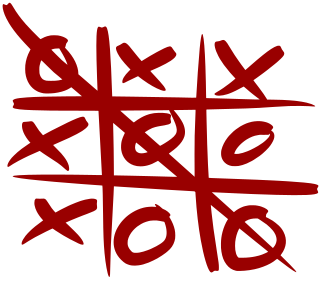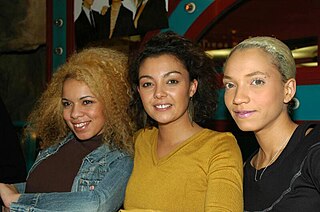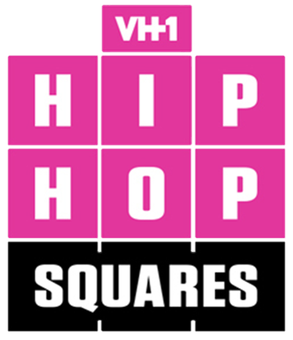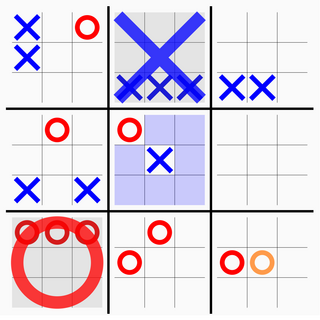
Tic-tac-toe, noughts and crosses, or Xs and Os is a paper-and-pencil game for two players who take turns marking the spaces in a three-by-three grid with X or O. The player who succeeds in placing three of their marks in a horizontal, vertical, or diagonal row is the winner. It is a solved game, with a forced draw assuming best play from both players.
TTT or Triple T may stand for:

3D tic-tac-toe, also known by the trade name Qubic, is an abstract strategy board game, generally for two players. It is similar in concept to traditional tic-tac-toe but is played in a cubical array of cells, usually 4×4×4. Players take turns placing their markers in blank cells in the array. The first player to achieve four of their own markers in a row wins. The winning row can be horizontal, vertical, or diagonal on a single board as in regular tic-tac-toe, or vertically in a column, or a diagonal line through four boards.
Tic-tac is a traditional method of signs used by bookmakers to communicate the odds of certain horses. Until the turn of the 21st century it was a very common sight on racecourses in the UK, but with the advent of mobile technology it is now seldom seen. In 1999, only three practitioners were noted to be still working on the southern UK tracks – Micky 'Hokey' Stuart, Billie Brown and Rocky Roberts. A tic-tac man will usually wear bright white gloves to make his hand movements easily seen.
Comeback, The Comeback or Come Back may refer to:
A tick is a parasitic mite of the order Ixodida.
A toe is a digit of the foot of a human or animal.
Tick tock, tic toc, Tik Tok and other variants may refer to:

Tic Tac Toe were a German girl group formed in 1995, performing pop-rap music. Their first two albums, Tic Tac Toe and Klappe die 2te, were million-selling commercial successes and spawned major hits "Ich find' dich scheiße", "Verpiss' dich" and "Warum?". The band found biggest popularity in German speaking countries, the Netherlands and Eastern Europe. Due to numerous scandals and personal issues between the group members, Tic Tac Toe split in 2001. The band had a successful but short-lived comeback in 2005 with the hit single "Spiegel", but ultimately disbanded in 2007.

Toss Across is a game first introduced in 1969 by the now defunct Ideal Toy Company. The game was designed by Marvin Glass and Associates and created by Hank Kramer, Larry Reiner and Walter Moe, and is now distributed by Mattel. It is a game where participants play tic-tac-toe by lobbing small beanbags at targets in an attempt to change the targets to their desired letter. As in traditional tic-tac-toe, the first player to get three of their letters in a row wins the game. There are other similar games to Toss Across known under different names, like Tic Tac Throw.

Quantum tic-tac-toe is a "quantum generalization" of tic-tac-toe in which the players' moves are "superpositions" of plays in the classical game. The game was invented by Allan Goff of Novatia Labs, who describes it as "a way of introducing quantum physics without mathematics", and offering "a conceptual foundation for understanding the meaning of quantum mechanics".

Hip Hop Squares is an American television game show originally hosted by Peter Rosenberg, which debuted on MTV2 on May 22, 2012. The show is a licensed format of CBS Television Distribution's Hollywood Squares featuring mostly rappers. The MTV2 version of the show was taped in Brooklyn, New York. The VH1 version was taped in Hollywood, California.
X's and O's, Exes and Ohs, Ex's and Oh's, and other variants in spelling of that phrase may refer to:
Tic Tac Toe, also known as noughts and crosses or Xs and Os, is a paper-and-pencil game for two players.
Noughts and Crosses is an alternative name for the game of Tic-tac-toe.

Ultimate tic-tac-toe is a board game composed of nine tic-tac-toe boards arranged in a 3 × 3 grid. Players take turns playing on the smaller tic-tac-toe boards until one of them wins on the larger board. Compared to traditional tic-tac-toe, strategy in this game is conceptually more difficult and has proven more challenging for computers.

Notakto is a tic-tac-toe variant, also known as neutral or impartial tic-tac-toe. The game is a combination of the games tic-tac-toe and Nim, played across one or several boards with both of the players playing the same piece. The game ends when all the boards contain a three-in-a-row of Xs, at which point the player to have made the last move loses the game. However, in this game, unlike tic-tac-toe, there will always be a player who wins any game of Notakto.

Tic-tac-toe is an instance of an m,n,k-game, where two players alternate taking turns on an m×n board until one of them gets k in a row. Harary's generalized tic-tac-toe is an even broader generalization. The game can also be generalized as a nd game. The game can be generalised even further from the above variants by playing on an arbitrary hypergraph where rows are hyperedges and cells are vertices.
Combinatorial Games: Tic-Tac-Toe Theory is a monograph on the mathematics of tic-tac-toe and other positional games, written by József Beck. It was published in 2008 by the Cambridge University Press as volume 114 of their Encyclopedia of Mathematics and its Applications book series (ISBN 978-0-521-46100-9).
This page is based on this
Wikipedia article Text is available under the
CC BY-SA 4.0 license; additional terms may apply.
Images, videos and audio are available under their respective licenses.







